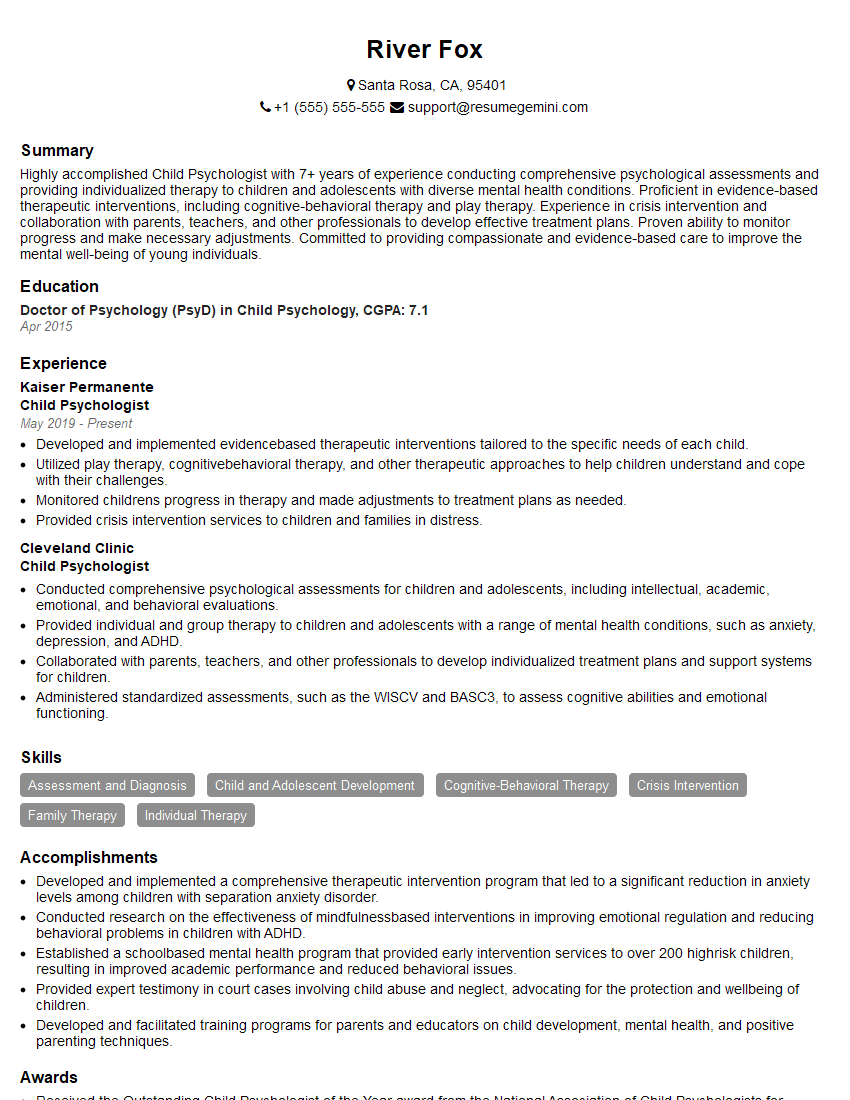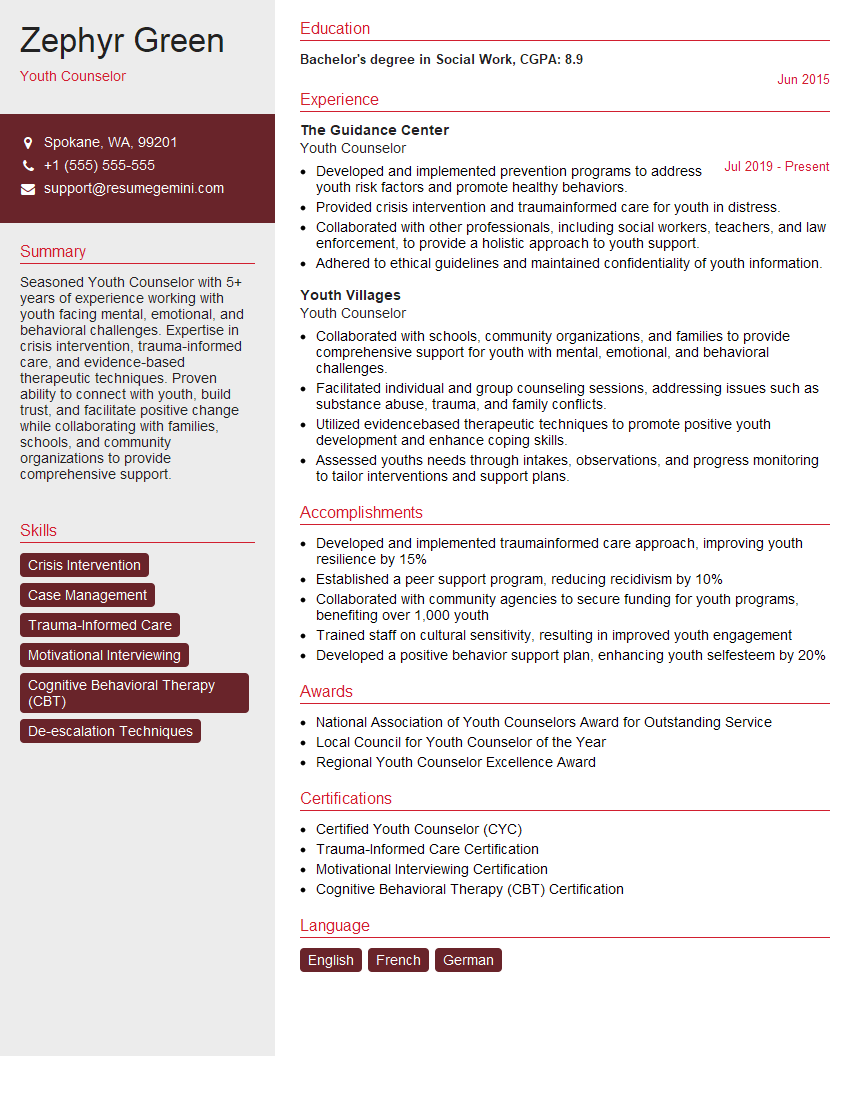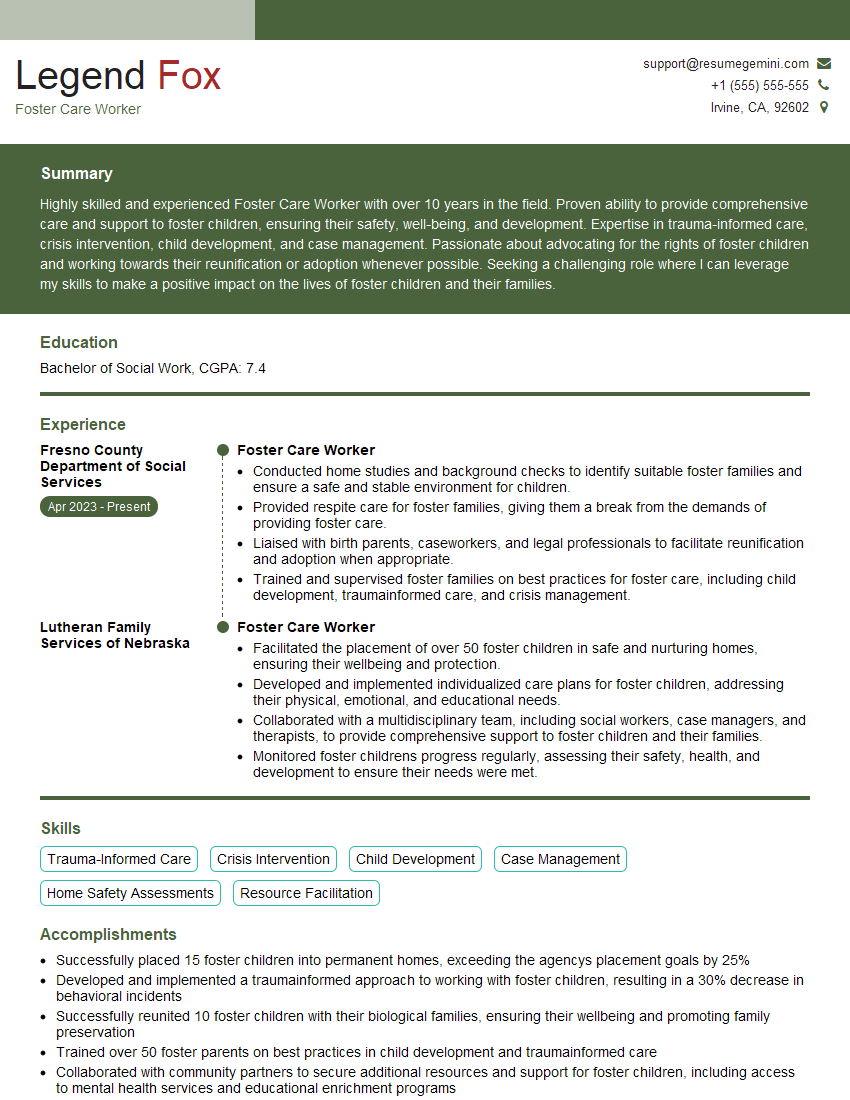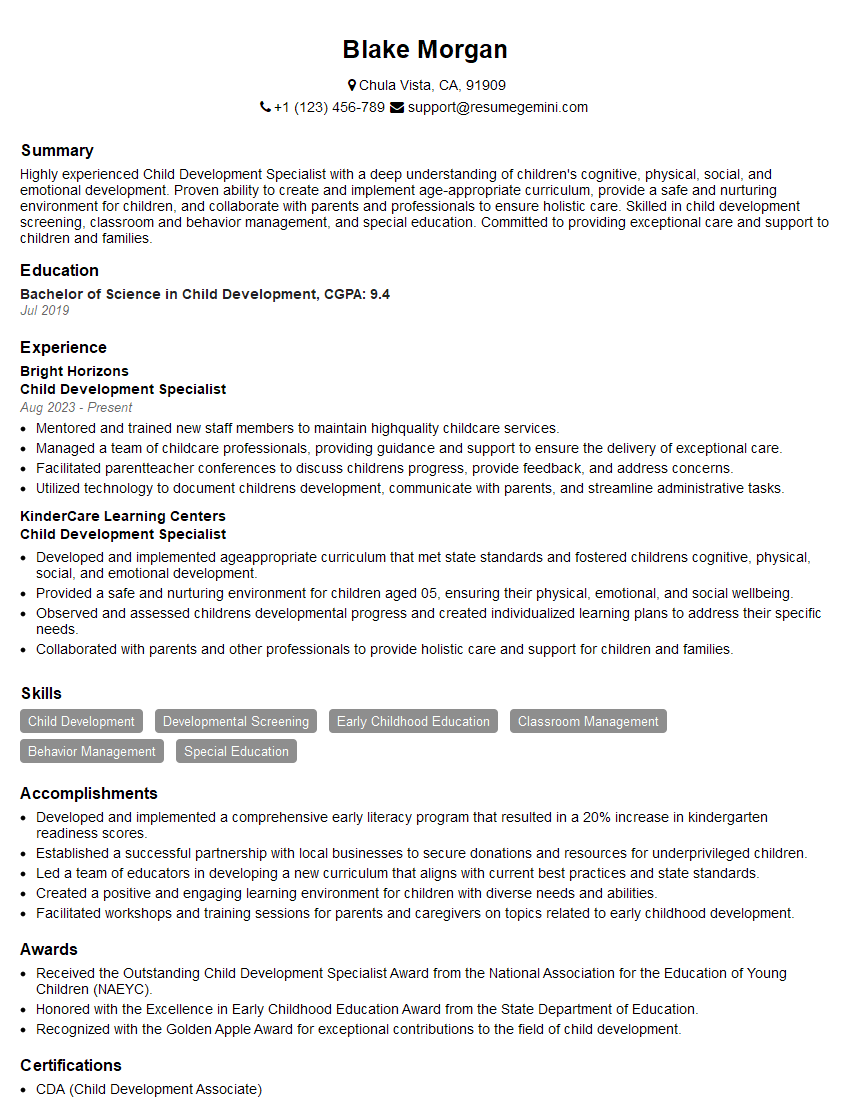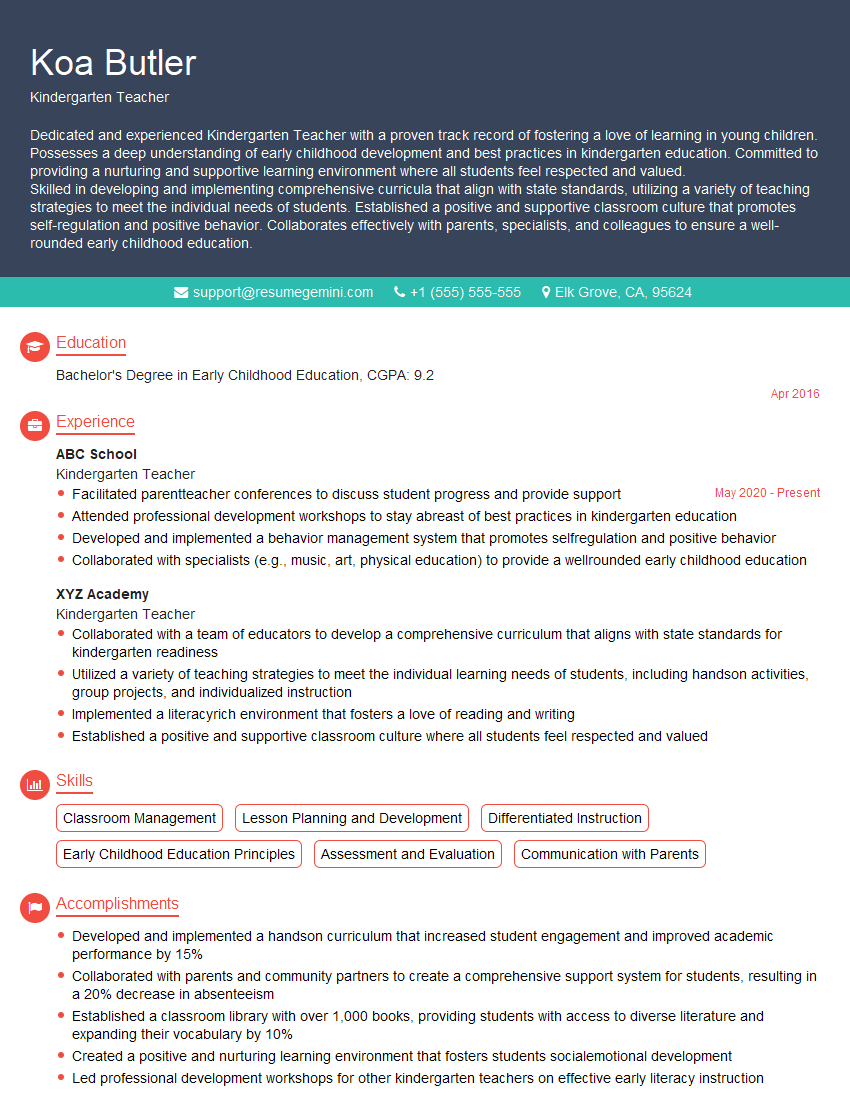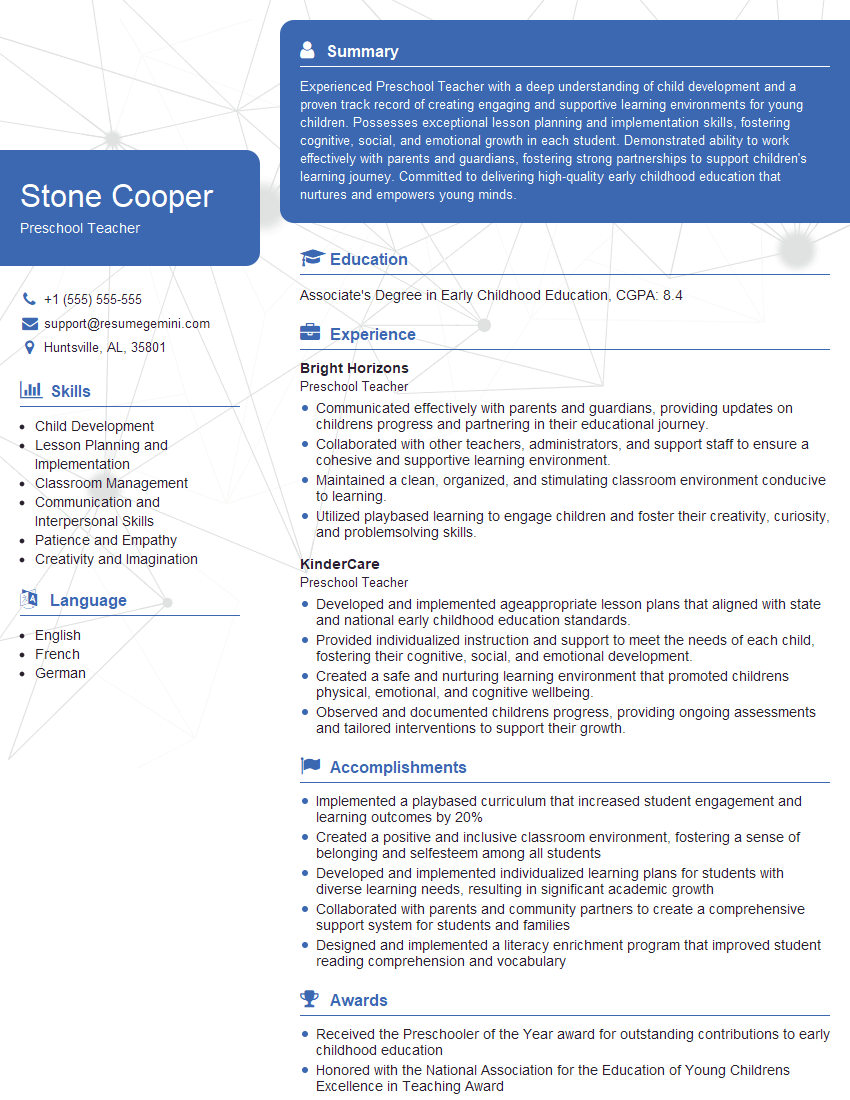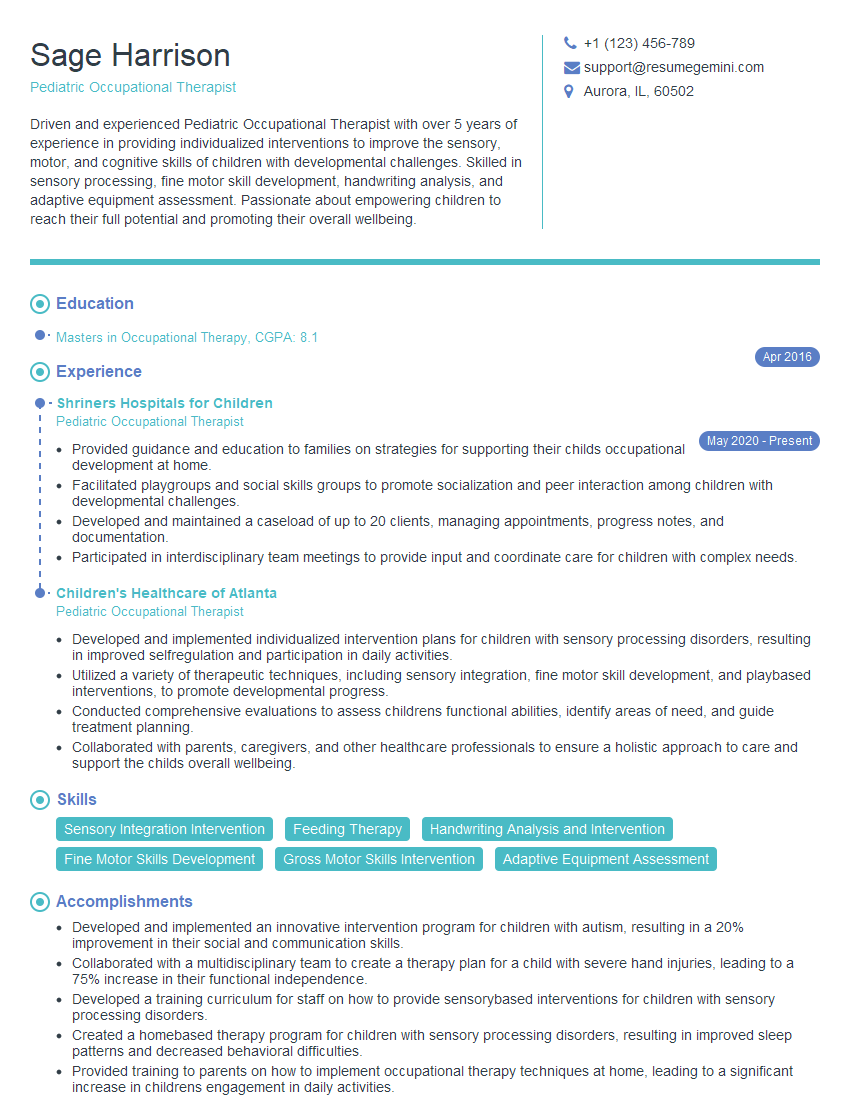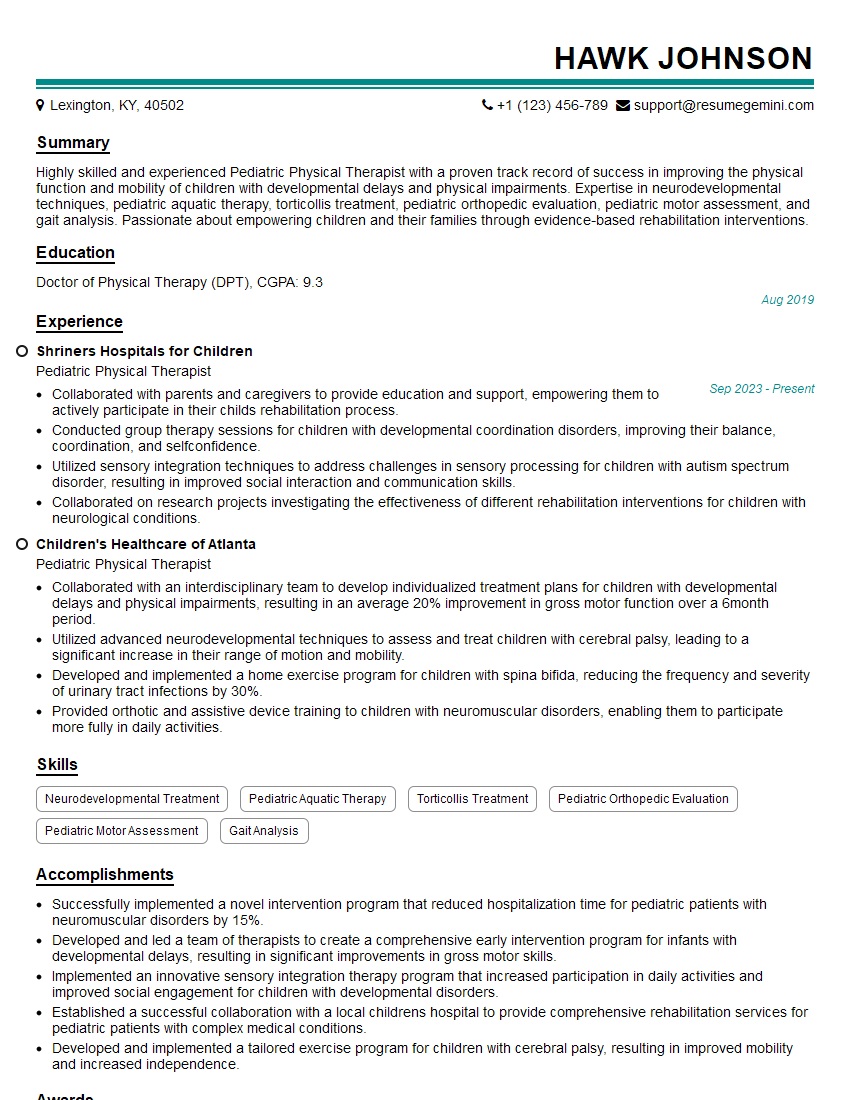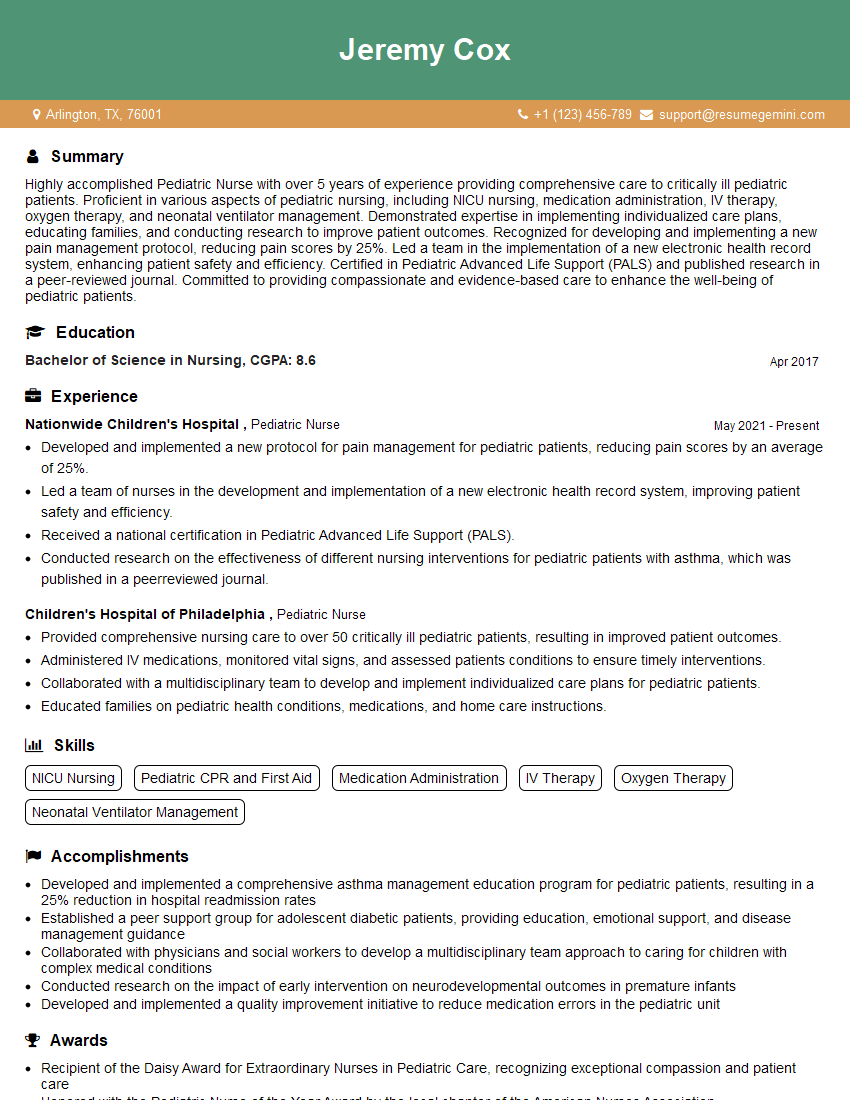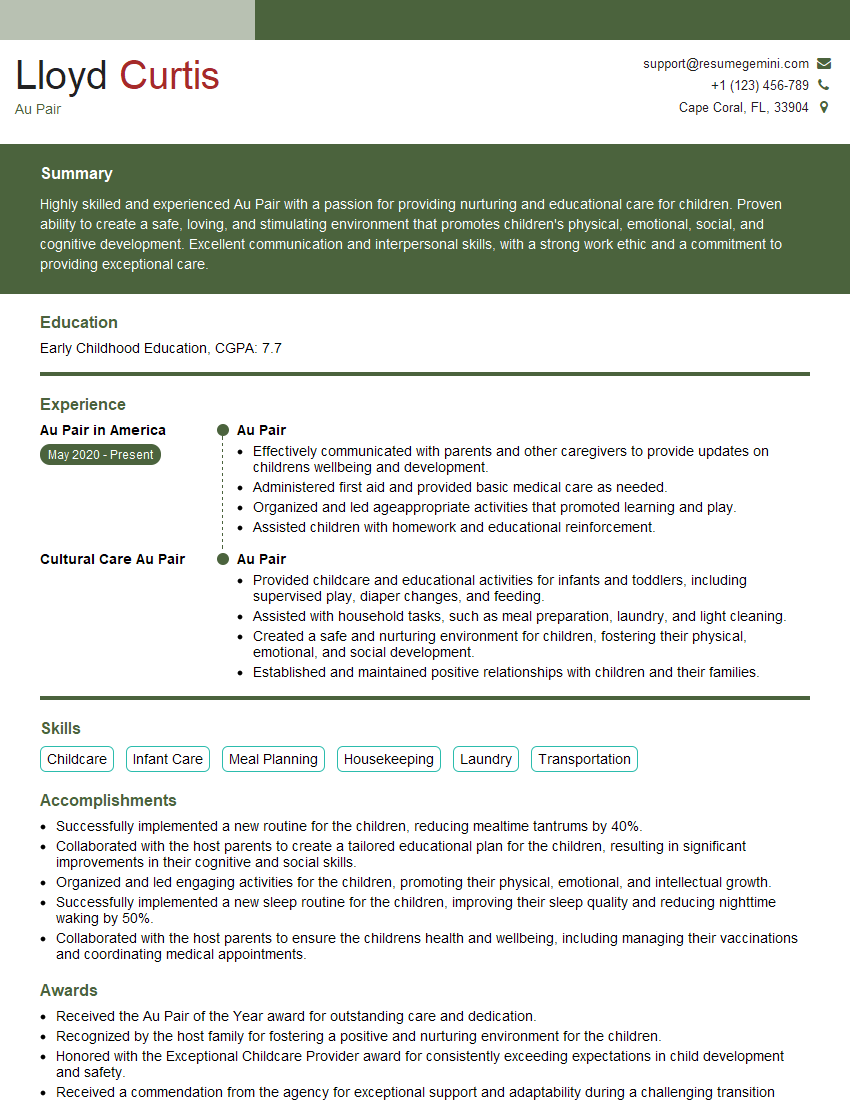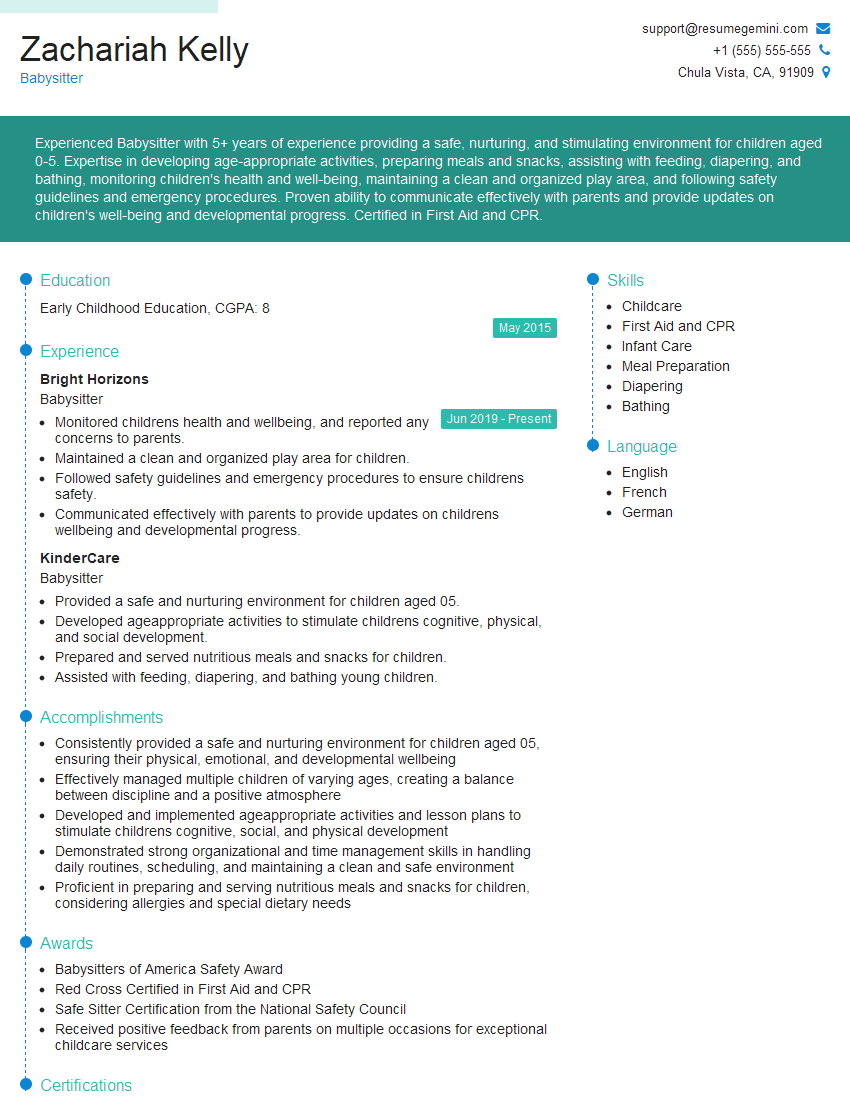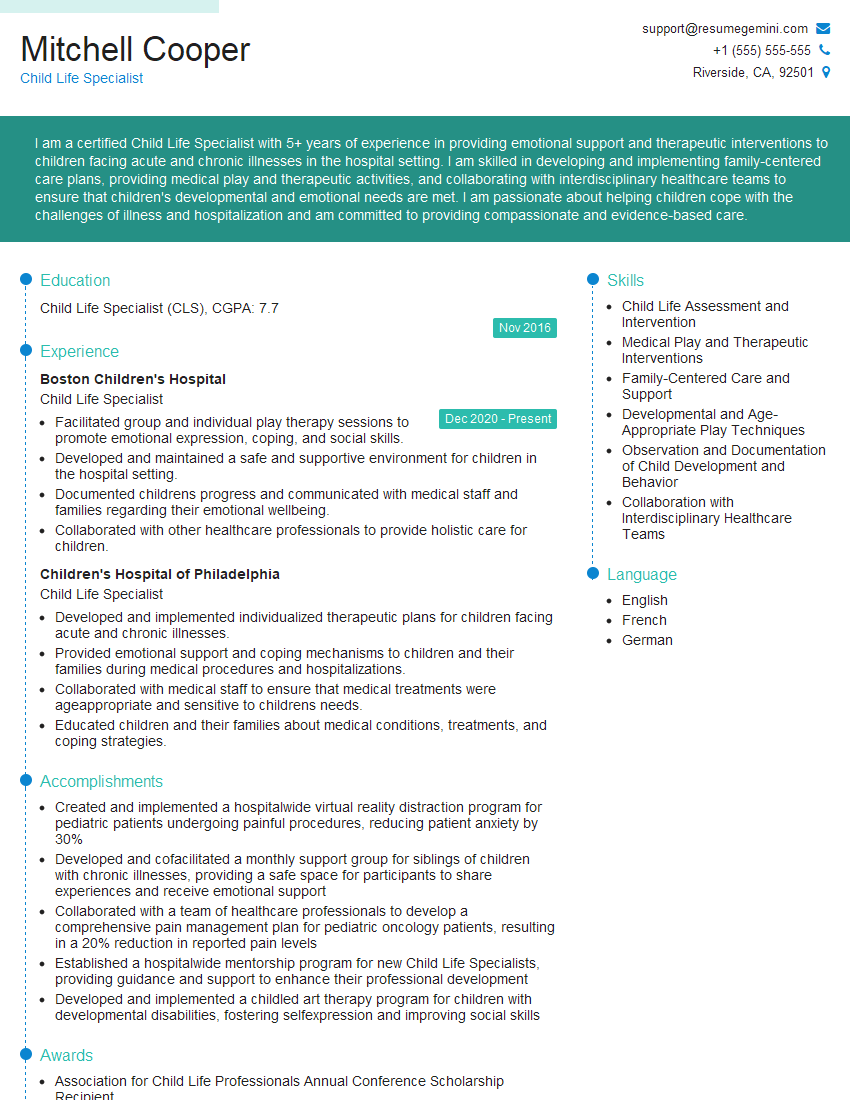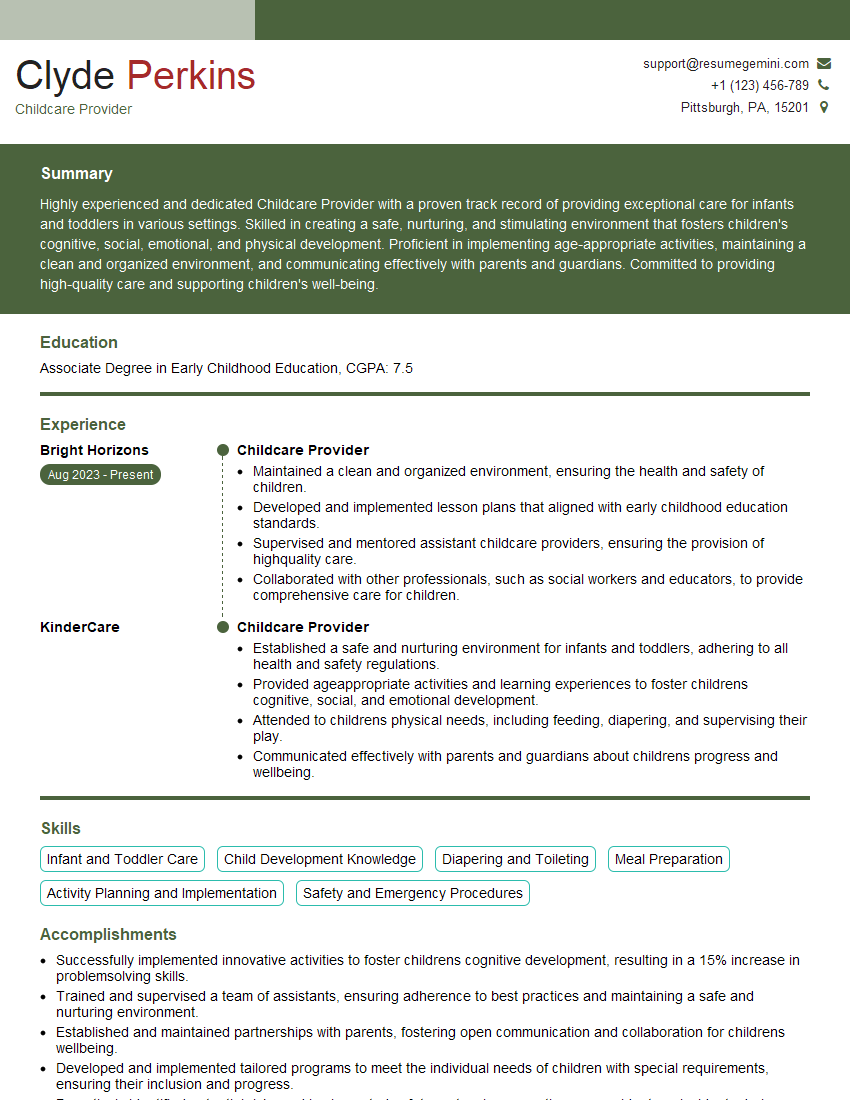Interviews are opportunities to demonstrate your expertise, and this guide is here to help you shine. Explore the essential Ability to work with children interview questions that employers frequently ask, paired with strategies for crafting responses that set you apart from the competition.
Questions Asked in Ability to work with children Interview
Q 1. Describe your experience managing challenging behaviors in children.
Managing challenging behaviors in children requires a multifaceted approach that prioritizes understanding the root cause of the behavior, rather than simply suppressing it. My experience involves employing positive behavior support strategies, focusing on proactive interventions and teaching replacement behaviors.
Positive Reinforcement: I consistently reward positive behaviors with praise, privileges, or small rewards, reinforcing desired actions. For instance, if a child is struggling with interrupting, I might praise them when they wait patiently for their turn to speak and offer a sticker or verbal affirmation.
Functional Behavior Assessment (FBA): I conduct FBAs to identify the triggers and functions of challenging behaviors. This helps me understand *why* a child is behaving a certain way, allowing for more effective interventions. For example, a child might be acting out because they are feeling overwhelmed, hungry, or seeking attention. Addressing the underlying need is crucial.
Consistency and Clear Expectations: Establishing clear rules and consistent consequences is vital. Children thrive in predictable environments, and consistent application of rules minimizes confusion and power struggles. This includes clearly outlining expectations in a positive manner, focusing on what *should* be done rather than what shouldn’t.
Collaboration with Parents/Guardians: Consistent communication with parents or guardians is essential to ensure a unified approach to behavior management. This involves sharing observations, strategies, and progress updates to maintain continuity between home and school environments.
For instance, I once worked with a child who consistently threw tantrums. After conducting an FBA, we discovered that the tantrums were a way to avoid challenging tasks. We then implemented a graduated reward system for completing tasks, breaking them down into smaller, more manageable steps, building the child’s confidence and reducing the need for tantrums.
Q 2. How do you adapt your teaching methods to different learning styles?
Recognizing that children learn in diverse ways is fundamental to effective teaching. I adapt my methods by incorporating a variety of teaching styles catering to visual, auditory, and kinesthetic learners. This multi-sensory approach ensures engagement and comprehension for all children.
Visual Learners: For visual learners, I utilize diagrams, charts, flashcards, videos, and other visual aids. I might use colored markers to highlight key concepts or create mind maps to organize information.
Auditory Learners: I use verbal explanations, discussions, lectures, and audio recordings. I might involve singing songs related to the topic or reading aloud to engage auditory learners.
Kinesthetic Learners: Hands-on activities, role-playing, experiments, and movement are crucial for kinesthetic learners. For example, while learning about fractions, students might use manipulatives like fraction circles or build structures representing fractions.
Differentiated Instruction: I differentiate instruction by offering varied activities and assignments according to individual learning needs. This might involve providing different levels of challenge, varying the formats of assignments (e.g., written, oral, artistic), or allowing students to choose the method they prefer for demonstrating their understanding.
For example, when teaching about the solar system, I might use a 3D model for visual learners, read aloud a story about planets for auditory learners, and have them build a solar system model using playdough for kinesthetic learners.
Q 3. Explain your approach to creating a safe and stimulating learning environment.
Creating a safe and stimulating learning environment is paramount. This involves establishing clear rules, fostering a sense of community, and providing a variety of engaging activities that stimulate curiosity and learning.
Physical Safety: A safe environment is free from hazards and promotes physical well-being. This involves regular checks for safety hazards and implementing appropriate safety measures, such as securing cabinets and ensuring appropriate supervision during activities.
Emotional Safety: Children must feel emotionally safe and accepted. This involves creating a classroom culture of respect, empathy, and inclusivity. Open communication and positive reinforcement are vital in fostering this.
Stimulating Environment: The classroom should be rich in learning materials and visually appealing. I organize the space to encourage exploration and creativity while promoting focus and independence. I use varied learning centers or activity stations to cater to different learning preferences.
Clear Expectations & Routines: Clearly established rules and daily routines give children a sense of security and predictability. Visual schedules and routines make daily tasks clear and decrease anxiety.
For instance, I always ensure that the classroom is organized and clutter-free, creating a calming atmosphere for learning. I establish clear classroom rules with the children’s input, fostering ownership and responsibility. The classroom is equipped with various learning materials, such as building blocks, art supplies, and books, to cater to diverse interests and learning styles.
Q 4. What strategies do you use to build rapport with children?
Building rapport with children involves creating a connection based on trust, respect, and understanding. It’s about showing genuine interest in them as individuals.
Active Listening: I pay close attention to what children say, both verbally and nonverbally. I ask open-ended questions to encourage them to share their thoughts and feelings.
Positive Interactions: I initiate positive interactions regularly. Simple things like smiling, making eye contact, and using their names create a feeling of connection.
Empathy and Understanding: I try to understand their perspective and validate their feelings, even if I don’t necessarily agree with their actions. Showing empathy builds trust and strengthens the relationship.
Shared Activities: Engaging in shared activities, like games or reading together, creates a more informal, relaxed environment that allows for bonding.
For example, I always take time to greet each child individually at the beginning of the day, asking about their weekend or something specific I know they enjoy. This small act demonstrates that I care about them individually.
Q 5. How do you handle conflicts between children?
Handling conflicts between children requires a fair and impartial approach that focuses on teaching conflict resolution skills.
Active Listening & Mediation: I help each child express their perspective without interrupting, ensuring they feel heard and understood. I facilitate a dialogue, guiding them to find a solution together.
Teaching Conflict Resolution Skills: I explicitly teach children skills such as taking turns, sharing, and compromising. Role-playing scenarios can be very effective.
Fairness and Impartiality: I remain neutral, avoiding taking sides. My role is to guide the children to resolve the conflict themselves, promoting fairness and respect.
Consequences for Aggressive Behavior: Aggressive behaviors are addressed with appropriate consequences, reinforcing the importance of peaceful conflict resolution. This may include time-outs, loss of privileges, or other age-appropriate discipline.
For instance, if two children are arguing over a toy, I’d guide them through a process of sharing the toy for a set amount of time each, or finding alternative solutions like finding a similar toy to share.
Q 6. Describe your experience working with children with special needs.
My experience working with children with special needs emphasizes individualized support and collaboration. I adapt my teaching methods and environment to meet their unique needs. I firmly believe in an inclusive approach, ensuring all children feel valued and supported.
Individualized Education Programs (IEPs): I actively participate in developing and implementing IEPs, tailoring my instruction to the child’s specific learning goals and needs.
Assistive Technology: I utilize assistive technology as needed, such as communication devices, visual supports, or adaptive learning materials to enhance the child’s learning experience.
Collaboration with Specialists: I work closely with therapists, specialists, and parents to create a coordinated support system. This includes sharing observations and collaborating on strategies for best supporting the child.
Creating an Inclusive Classroom: I ensure the classroom is inclusive and accessible to all students. This includes physical accessibility, as well as providing accommodations and modifications to meet individual needs.
For example, I worked with a child with autism who benefited significantly from a structured visual schedule and the use of a communication board. Through collaboration with the child’s therapist and parents, we developed strategies to manage sensory sensitivities and support his social-emotional development.
Q 7. How do you assess a child’s developmental progress?
Assessing a child’s developmental progress involves using a variety of methods to gauge their skills and abilities across different developmental domains. This isn’t a one-time assessment, but rather an ongoing process.
Observations: I regularly observe children in various settings, noting their behavior, interactions, and skills during both structured activities and free play.
Developmental Checklists and Screenings: I use standardized checklists and screenings designed to assess development in areas such as language, motor skills, social-emotional development, and cognitive abilities.
Formal Assessments: In some cases, more formal assessments, such as standardized tests, may be necessary to gain a more detailed understanding of a child’s strengths and areas for growth.
Portfolio Assessment: Collecting samples of children’s work (drawings, writings, projects) allows for a comprehensive view of their progress over time. This provides evidence of growth and informs future instruction.
Parent/Guardian Input: I regularly communicate with parents/guardians, gathering their insights and perspectives on their child’s development at home.
For example, I might observe a child’s language development during a story time, note their progress on a fine motor skills checklist while engaging in art activities, and collaborate with parents to gain a comprehensive view of their overall development.
Q 8. How do you incorporate play-based learning into your curriculum?
Play-based learning is the cornerstone of my teaching philosophy. I believe children learn best through active engagement and exploration. Instead of rote memorization, I design activities that allow children to discover concepts naturally within a playful context.
For example, in teaching math, instead of worksheets, we might use building blocks to explore shapes, sizes, and quantities. To learn about letters and sounds, we might create a puppet show where each character’s name starts with a different letter. Storytelling and dramatic play are frequently used to build vocabulary and develop social skills. I carefully plan these activities to align with age-appropriate developmental milestones and learning objectives, ensuring they are both engaging and educationally valuable.
- Structured Free Play: I provide a structured environment with various learning centers (art, blocks, dramatic play, etc.) allowing children to choose their activities. This fosters independence and creativity.
- Theme-Based Learning: Integrating a thematic approach allows for deeper exploration. For instance, a ‘farm’ theme could involve creating farm animals out of clay, writing stories about farm life, and learning about different types of crops.
- Assessment through Observation: Instead of formal tests, I observe children’s play to assess their understanding and progress. This allows for a more holistic understanding of their capabilities.
Q 9. What are your methods for maintaining classroom discipline?
Maintaining classroom discipline is about creating a positive and predictable learning environment, not about punishment. My approach focuses on proactive strategies to prevent disruptive behavior, rather than reacting to it.
Positive Reinforcement: I actively praise positive behaviors, and use reward systems like sticker charts or class privileges. This encourages children to repeat desirable actions. Clear Expectations: I establish clear rules and expectations from the beginning, explaining them in age-appropriate language, and consistently enforcing them. These rules are visually displayed in the classroom. Redirection: When a child misbehaves, I try to redirect their attention to a more appropriate activity, offering choices and explaining why their behavior was inappropriate. Individualized Approach: I recognize that each child is different. What works for one may not work for another. I observe each child’s behavior patterns to understand their triggers and tailor my strategies accordingly. For example, a child who is often disruptive might benefit from more one-on-one attention or opportunities for movement breaks.
If a behavior persists despite these strategies, I consult with the child’s parents/guardians to collaborate on a solution. My goal is to teach self-regulation and conflict resolution skills.
Q 10. How do you communicate effectively with parents/guardians?
Effective communication with parents/guardians is crucial for a child’s success. I strive to build strong, trusting relationships built on open and honest communication.
Regular Communication: I use a variety of methods to communicate including daily or weekly newsletters, parent-teacher conferences, email updates, and phone calls. I share both positive achievements and areas where support might be beneficial. Positive Language: When communicating concerns, I use positive language focusing on solutions and collaborative problem-solving, rather than criticism. For example, instead of saying “Johnny is disruptive,” I might say, “Johnny is having difficulty staying focused during group activities. Let’s explore strategies to help him.” Accessibility: I am readily available through multiple channels, making it easy for parents to reach me with questions or concerns.
I also actively seek feedback from parents. This helps me tailor my teaching approach to better meet the needs of each child.
Q 11. Describe your experience with emergency procedures involving children.
I have extensive experience with emergency procedures involving children. I am CPR and First Aid certified and have participated in numerous safety training sessions.
Emergency Drills: I regularly conduct fire drills, lockdown drills, and evacuation procedures to ensure that children and staff know what to do in an emergency. These drills are age-appropriate and conducted in a calm, reassuring manner. Incident Reporting: I am proficient in documenting and reporting any incidents or accidents, ensuring that appropriate measures are taken. Communication: In the event of an emergency, I prioritize clear and immediate communication with parents, emergency services, and the school administration. I follow established protocols to maintain order and ensure the safety of all involved.
Prior to employment, I reviewed and thoroughly understand the specific emergency protocols and procedures of the school or childcare facility.
Q 12. How do you ensure the physical and emotional safety of children in your care?
Ensuring the physical and emotional safety of children is my top priority. I maintain a safe and nurturing classroom environment by:
- Safe Environment: Regularly inspecting the classroom to eliminate potential hazards. This includes checking for broken toys, sharp objects, and ensuring that furniture is stable.
- Supervision: Providing constant and vigilant supervision, particularly during outdoor play and transitions between activities.
- Injury Prevention: Implementing age-appropriate safety rules and teaching children about safe practices, such as handwashing and playground safety.
- Emotional Safety: Creating a classroom culture of respect, kindness, and empathy. I teach conflict resolution skills and provide a safe space for children to express their emotions.
- Child Protection Policies: I am familiar with and strictly adhere to all relevant child protection policies and procedures, including reporting any suspected abuse or neglect.
Q 13. How familiar are you with child development milestones?
I have a strong understanding of child development milestones. I regularly consult resources like the CDC and other reputable sources to stay up-to-date on the latest research and best practices. This knowledge helps me to:
- Individualized Learning: Tailor my teaching methods to meet the individual developmental needs of each child. I adjust the complexity of activities and provide extra support when needed.
- Early Identification: Recognize potential developmental delays or concerns and refer children to appropriate professionals for assessment and intervention.
- Curriculum Planning: Design age-appropriate activities that align with children’s developmental stages. This ensures that children are challenged appropriately and avoid frustration or boredom.
- Communication with Parents: Effectively communicate with parents about their child’s progress and any developmental concerns.
For example, I understand that a typical three-year-old might be mastering basic self-help skills, while a five-year-old might be developing more advanced language and literacy abilities. I use this knowledge to design lessons and activities that appropriately challenge and engage children at each stage of development.
Q 14. What is your approach to teaching children about safety rules?
Teaching children about safety rules is an ongoing process that involves repetition, modeling, and positive reinforcement. I use age-appropriate methods and incorporate interactive activities to ensure understanding.
Interactive Lessons: Instead of simply lecturing, I use interactive methods like role-playing, stories, and games to teach safety rules. For example, we might act out different scenarios like crossing the street safely or what to do if approached by a stranger. Visual Aids: I use posters, charts, and other visual aids to reinforce safety rules. Repetition: I regularly review safety rules with children, ensuring they become second nature. Practice: We practice safety procedures, such as fire drills and emergency evacuations, regularly. Age-Appropriate Language: I use clear, simple language that children can easily understand, avoiding jargon or overly technical terms. Positive Reinforcement: I praise children when they demonstrate safe behavior.
I teach children to ‘stop, think, and act’ before engaging in potentially risky situations and empower them to ask for help when needed.
Q 15. How do you handle a situation where a child is exhibiting signs of abuse or neglect?
Suspecting abuse or neglect in a child is a serious matter requiring immediate and careful action. My first step is to carefully observe the child for any physical signs (unexplained bruises, burns, injuries), behavioral indicators (withdrawal, fear of adults, sudden changes in behavior), and consistent reporting of concerning events from the child themselves. I would then document everything meticulously, noting dates, times, specific observations, and any statements made by the child. This documentation is crucial for future reporting. The next critical step is to report my concerns to the appropriate authorities, such as Child Protective Services (CPS) or the police, according to my organization’s established protocols. This is mandated by law in many jurisdictions. It’s vital to remember that I am a mandated reporter, and failing to report suspected abuse or neglect would be a serious ethical and legal breach. I would also offer the child a safe and supportive environment, assuring them they are safe and that what they have experienced is not their fault. My focus would be on their safety and well-being, while also working closely with the authorities to ensure a thorough investigation.
For example, if a child repeatedly comes to school with unexplained bruises and seems fearful of an adult, I would document this, including the dates, the locations of bruises, and any statements made by the child. This documentation would be used to support my report to CPS, ensuring that a qualified professional can assess the situation.
Career Expert Tips:
- Ace those interviews! Prepare effectively by reviewing the Top 50 Most Common Interview Questions on ResumeGemini.
- Navigate your job search with confidence! Explore a wide range of Career Tips on ResumeGemini. Learn about common challenges and recommendations to overcome them.
- Craft the perfect resume! Master the Art of Resume Writing with ResumeGemini’s guide. Showcase your unique qualifications and achievements effectively.
- Don’t miss out on holiday savings! Build your dream resume with ResumeGemini’s ATS optimized templates.
Q 16. How do you promote inclusivity and respect among children?
Promoting inclusivity and respect among children requires a multifaceted approach that starts with establishing a classroom environment built on kindness, empathy, and understanding. I achieve this through several key strategies. First, I explicitly teach children about diversity, celebrating differences in backgrounds, abilities, and perspectives. This includes incorporating diverse stories, characters, and perspectives into classroom activities and curriculum. Second, I actively model inclusive behavior myself, consistently demonstrating respect and valuing each child’s unique contributions. Third, I implement classroom rules and routines that explicitly discourage bullying, teasing, and discrimination. I teach conflict resolution skills, providing children with tools to address disagreements peacefully and respectfully. Fourth, I create opportunities for children to interact and collaborate in diverse groups, encouraging teamwork and shared responsibility. Finally, I involve parents and caregivers in these efforts, seeking their help in reinforcing these values at home. This collaboration between school and home creates a strong, consistent message about inclusivity and respect for all.
For example, I might use cooperative learning activities where children with differing skills must work together to accomplish a goal. This teaches them not only the value of teamwork but also the strengths of their peers, breaking down stereotypes and fostering respect for different abilities.
Q 17. Describe your experience with lesson planning and curriculum development.
My experience with lesson planning and curriculum development is extensive. I approach lesson planning using a backward design model, starting with identifying clear learning objectives aligned with relevant standards. This is followed by selecting appropriate teaching methods and activities to meet those objectives, considering the developmental stage and learning styles of the children. For example, when planning a lesson on fractions, I consider not just the mathematical concepts but also the children’s cognitive abilities. If I’m teaching five-year-olds, I will use hands-on activities like cutting pizzas, sharing candies, or using manipulatives, building a foundational understanding of parts of a whole. For older children, I would use more abstract representations like diagrams and equations. I incorporate a variety of teaching strategies, including active learning, inquiry-based learning, and project-based learning, to keep the children engaged and foster deeper understanding. I consistently evaluate the effectiveness of my lessons and adjust my approach as needed, using formative assessments throughout the learning process. Curriculum development involves a similar process but on a larger scale, requiring collaboration with colleagues, considering long-term goals, and ensuring alignment with broader educational frameworks.
Q 18. How do you differentiate instruction to meet the needs of individual children?
Differentiating instruction is essential for catering to the diverse learning needs of individual children. I use a variety of strategies to achieve this. First, I conduct thorough assessments to understand each child’s strengths, weaknesses, and learning preferences. This involves both formal and informal assessments, such as observations, standardized tests, and projects. Based on these assessments, I adapt my teaching methods and materials to meet individual needs. This could involve providing differentiated tasks, where children work on assignments that are tailored to their skill level. I might also offer different levels of support, providing more assistance to some children while challenging others with more complex activities. For example, while teaching about dinosaurs, some children might be writing simple sentences about their favourite dinosaur, while others might be writing a full-length story, including details of the time period and habitat. Furthermore, I provide opportunities for flexible grouping, allowing children to work independently, in pairs, or in small groups, depending on their needs and the specific activity. This combination of assessment, task differentiation, varied support, and flexible grouping helps ensure that all children are challenged and supported appropriately, promoting inclusive learning.
Q 19. What methods do you use to assess children’s understanding of concepts?
Assessing children’s understanding requires a combination of methods to capture a complete picture of their learning. I use a variety of formal and informal assessments. Formal assessments, such as tests and quizzes, provide a standardized way to measure knowledge and skills. However, I also rely heavily on informal assessments, like observations of children’s participation in class discussions, their work on projects, and their performance on hands-on activities. These informal assessments provide valuable insights into children’s understanding that might not be captured by formal tests. For example, observing a child building a model of a volcano after a science lesson reveals their understanding of the concept in a practical, hands-on way. I also use formative assessments throughout the learning process, providing ongoing feedback and adjusting instruction as needed. This allows me to identify areas where children are struggling and provide targeted support. Finally, I often involve children in self-assessment activities, helping them reflect on their own learning and identify areas for improvement. Combining these various assessment methods gives me a holistic and accurate picture of each child’s progress and understanding.
Q 20. How do you foster creativity and imagination in children?
Fostering creativity and imagination in children requires creating an environment that encourages exploration, experimentation, and risk-taking. I achieve this by providing opportunities for open-ended activities, such as art projects, dramatic play, storytelling, and building activities. These activities allow children to express themselves freely and develop their own unique ideas. I incorporate elements of surprise and wonder into my lessons, using engaging stories, visuals, and hands-on experiences. I also encourage children to ask “what if” questions and to think outside the box. For example, during a science lesson on the water cycle, instead of simply explaining the process, I might challenge the children to create a model of the water cycle using everyday objects. This kind of open-ended activity encourages creativity and allows children to demonstrate their understanding in a unique and imaginative way. Furthermore, providing a space for imaginative play, using props and costumes, allows children to explore different roles and scenarios, expanding their creative thinking skills and developing their communication skills. Praising creative solutions and efforts rather than just the end product fosters a sense of confidence in taking creative risks.
Q 21. How do you address parental concerns and questions effectively?
Addressing parental concerns and questions effectively requires open communication, active listening, and a collaborative approach. I start by creating a welcoming environment where parents feel comfortable expressing their thoughts and concerns. I actively listen to their perspectives, showing empathy and understanding. I then clearly explain my teaching methods and classroom routines, answering their questions thoroughly and honestly. If I don’t have an immediate answer, I make sure to follow up promptly with information or resources. I emphasize the importance of a partnership between home and school, emphasizing the shared goal of supporting the child’s learning and development. I regularly communicate with parents through newsletters, parent-teacher conferences, emails, and phone calls, providing updates on their child’s progress and inviting them to share their observations and concerns. For example, if a parent expresses concern about their child’s reading ability, I might share specific examples from their work, discuss strategies I’m using in the classroom, and suggest activities they can do at home to support their child’s reading development. This collaborative approach ensures that we’re working together to create the best possible learning experience for the child.
Q 22. Describe a time you had to make a quick decision in a challenging situation with children.
One day, during a field trip to the zoo, a group of children got separated from the main group. One child, Lily, became visibly distressed and started crying. It was crucial to act quickly to ensure her safety and calm her down. Instead of panicking, I immediately took a deep breath and assessed the situation. I reassured Lily, confirming that we were still at the zoo and that we’d find the others. I then quickly scanned the immediate area, locating a nearby zoo employee. Collaborating with the employee, we used the zoo’s radio system to locate the other children and teachers. Within minutes, Lily was reunited with her class, and the stressful situation was resolved calmly and efficiently. This experience highlighted the importance of quick thinking, resourcefulness, and collaborative problem-solving in high-pressure child-related scenarios.
Q 23. What is your understanding of child psychology and its application in your work?
Understanding child psychology is fundamental to my work. It’s about recognizing that children’s emotional, social, and cognitive development significantly impacts their behavior and learning. For example, understanding Piaget’s stages of cognitive development helps me tailor activities to children’s specific developmental levels. Knowing that a preschooler thinks concretely, I use hands-on activities, while with older children, I can introduce abstract concepts. Similarly, Erikson’s stages of psychosocial development informs my approach to building trust and encouraging independence. If a child is struggling with a particular task, understanding their developmental stage helps me determine appropriate support. I also utilize knowledge of attachment theory to build strong, positive relationships that create a secure environment for learning and growth. This includes actively listening to their concerns and responding with empathy.
Q 24. How do you use positive reinforcement to motivate children?
Positive reinforcement is crucial for motivating children. It’s about focusing on rewarding desired behaviors rather than punishing undesired ones. I use a multi-pronged approach. For instance, specific praise – ‘I really appreciate how carefully you’re coloring within the lines’ – is far more effective than a generic ‘Good job.’ I also implement reward systems such as sticker charts, small prizes for consistent effort, or privileges earned through good behavior. Verbal praise and acknowledging effort are equally important. I’ve found that public acknowledgment of achievements, coupled with private encouragement, is very effective. Finally, I incorporate the principles of self-motivation. I let children set realistic goals and encourage them to monitor their own progress, reinforcing their sense of accomplishment and self-efficacy.
Q 25. How do you maintain confidentiality and protect children’s privacy?
Confidentiality and protecting children’s privacy are paramount. I strictly adhere to all relevant data protection regulations. I never disclose any information about a child to anyone not directly involved in their care, including parents unless required by law. Information is shared only with those who have a legitimate need to know. For instance, if a child discloses something concerning to me, I will immediately inform my supervisor following the established reporting procedures. I never share details on social media or in informal settings. I ensure all records are stored securely and only accessible to authorized personnel. I use anonymized data when presenting cases for training or professional development. The children’s wellbeing and privacy are the top priorities.
Q 26. How do you adapt your communication style to different age groups?
Adapting my communication style is essential for effective interaction with different age groups. With toddlers, I use simple language, lots of visual aids, and hands-on activities. I employ a playful tone, using songs and games to engage them. With elementary-aged children, I can use more complex sentences and introduce storytelling, while also maintaining clear and concise explanations. With teenagers, I foster open dialogue, recognizing their need for autonomy and respect for their opinions. I listen carefully, use age-appropriate language, and address them as individuals, considering their intellectual maturity and emotional needs. It’s about meeting them where they are developmentally and tailoring my communication accordingly.
Q 27. Describe your experience using various teaching aids and resources.
I have extensive experience using various teaching aids and resources. I regularly incorporate technology, using interactive whiteboards, educational apps, and online resources. I also use a wide range of traditional methods including puppets, storytelling, art supplies, manipulatives, and building blocks, adjusting materials to fit the specific learning objectives and the age group. For instance, using flashcards to teach vocabulary for younger children, whereas older children might benefit from more in-depth projects and discussions. I am adept at selecting and adapting resources to ensure they are engaging, relevant, and developmentally appropriate. I believe in integrating different media to make learning more interactive and fun.
Q 28. How would you respond to a parent complaining about your teaching methods?
Responding to a parent’s complaint requires a professional and empathetic approach. I would start by actively listening to their concerns without interruption, ensuring they feel heard and understood. I would then ask clarifying questions to fully grasp their perspective, taking notes to show my attentiveness. Once I have a clear understanding of their concerns, I would calmly and objectively explain my teaching methods and rationale, referencing relevant pedagogical principles. If there’s a misunderstanding, I would seek to clarify it. If there’s valid criticism, I would acknowledge it and discuss how I can improve my methods. I would work collaboratively with the parent to find a solution that benefits their child. Finally, I would follow up to ensure the issue is resolved and the parent feels valued and respected. The goal is to build a strong, positive partnership with parents to ensure the child’s success.
Key Topics to Learn for Ability to Work with Children Interviews
- Child Development & Stages: Understanding different age groups and their developmental needs (cognitive, emotional, social, physical). Consider how this impacts your approach to activities and communication.
- Safeguarding & Child Protection: Knowledge of relevant policies and procedures, including recognizing and reporting signs of abuse or neglect. Be prepared to discuss your understanding of creating a safe and nurturing environment.
- Communication & Interaction: Effective communication strategies for children of different ages and abilities. Think about how you build rapport, adapt your language, and handle challenging behaviors.
- Activity Planning & Engagement: Designing age-appropriate and engaging activities that promote learning, creativity, and social interaction. Be ready to give examples of activities you’ve planned or participated in.
- Behavior Management: Positive guidance techniques and strategies for managing challenging behaviors. Discuss your approach to discipline and conflict resolution in a child-friendly way.
- Working with Parents/Guardians: Effective communication and collaboration with parents or guardians to ensure a child’s well-being and progress. Consider how you would handle disagreements or concerns.
- Inclusive Practices: Understanding and implementing inclusive practices to support children with diverse needs and abilities. Prepare to discuss your experience or willingness to work with children with special needs.
Next Steps
Mastering the ability to work with children opens doors to rewarding careers in education, childcare, youth work, and more. A strong understanding of these key areas significantly boosts your interview success. To enhance your job prospects, creating an ATS-friendly resume is crucial. ResumeGemini can help you build a professional and impactful resume that highlights your relevant skills and experience. We provide examples of resumes tailored to “Ability to work with children” roles to guide you. Invest time in crafting a compelling resume—it’s your first impression on potential employers.
Explore more articles
Users Rating of Our Blogs
Share Your Experience
We value your feedback! Please rate our content and share your thoughts (optional).
What Readers Say About Our Blog
Hello,
We found issues with your domain’s email setup that may be sending your messages to spam or blocking them completely. InboxShield Mini shows you how to fix it in minutes — no tech skills required.
Scan your domain now for details: https://inboxshield-mini.com/
— Adam @ InboxShield Mini
Reply STOP to unsubscribe
Hi, are you owner of interviewgemini.com? What if I told you I could help you find extra time in your schedule, reconnect with leads you didn’t even realize you missed, and bring in more “I want to work with you” conversations, without increasing your ad spend or hiring a full-time employee?
All with a flexible, budget-friendly service that could easily pay for itself. Sounds good?
Would it be nice to jump on a quick 10-minute call so I can show you exactly how we make this work?
Best,
Hapei
Marketing Director
Hey, I know you’re the owner of interviewgemini.com. I’ll be quick.
Fundraising for your business is tough and time-consuming. We make it easier by guaranteeing two private investor meetings each month, for six months. No demos, no pitch events – just direct introductions to active investors matched to your startup.
If youR17;re raising, this could help you build real momentum. Want me to send more info?
Hi, I represent an SEO company that specialises in getting you AI citations and higher rankings on Google. I’d like to offer you a 100% free SEO audit for your website. Would you be interested?
Hi, I represent an SEO company that specialises in getting you AI citations and higher rankings on Google. I’d like to offer you a 100% free SEO audit for your website. Would you be interested?
good
